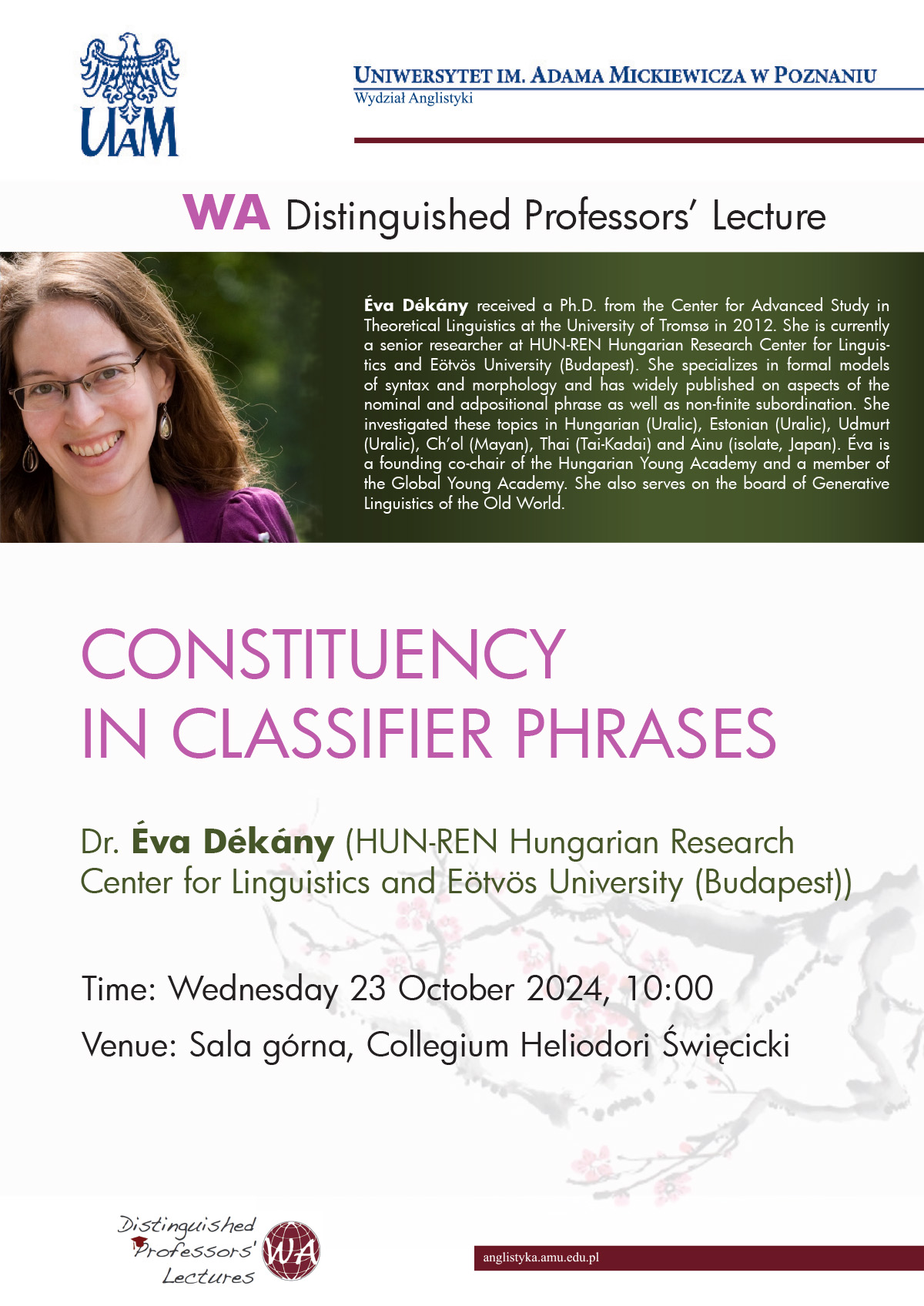Time: Wednesday 23 October 2024, 10:00
Venue: Sala górna, Collegium Heliodori Święcicki
Speaker: Dr. Éva Dékány (HUN-REN Hungarian Research Center for Linguistics and Eötvös University (Budapest))
Abstract
Classifiers are nominal auxiliaries which are required in the context of numerals in some languages (e.g., Mandarin Chinese “san-ben shu”, lit. three-Cl book, ‘three books’). One of the most significant open debates regarding the constituency of the NP centers around the question of whether the classifier forms a constituent with the noun or the numeral. Recent arguments in the literature supporting Num+Cl constituency are built on Ch'ol (Mayan) data involving phonological constituency, coordination, complex numeral formation, subextraction from the NP, and the use of numerals with classifiers in absence of a noun (Bale et al. 2019). I show how the Cl+N constituency analysis can also account for these data, and conclude that in order to adjudicate NP-internal constituency, we need to look elsewhere. An important upshot of this discussion will be that classifiers in Ch'ol are phrasal, and thus the syntactic category of classifiers is subject to cross-linguistic variation. I will then take up a previously proposed argument for Cl+N constituency involving repeater classifiers in Thai (Simpson 2005). Repeater classifiers occur when a noun is not compatible with any classifiers in a language but filling the classifier position is obligatory, nevertheless. In this case the noun itself is repeated in the classifier position (e.g., “laaj šaam laaj”, lit. pattern three Cl:repeater, ‘three patterns’). I will suggest that the existence of repeaters indeed supports Cl+N constituency, but the mechanism behind them is post-syntactic reduplication rather than movement.
- Bale, Alan, Jessica Coon & Nicholás Arcos López. 2019. Classifiers, partitions, and measurements: exploring the syntax and semantics of sortal classifiers. Glossa 4(1). Article 77. doi:10.5334/gjgl.752 [external link].
- Simpson, Andrew. 2005. Classifiers and DP structure in Southeast Asia. In Guglielmo Cinque & Richard S. Kayne (eds.), The Oxford handbook of comparative syntax, 806–838. New York: Oxford University Press. doi:10.1093/oxfordhb/9780195136517.013.0018 [external link]

About the speaker
 Éva Dékány received a Ph.D. from the Center for Advanced Study in Theoretical Linguistics at the University of Tromsø in 2012. She is currently a senior researcher at HUN-REN Hungarian Research Center for Linguistics and Eötvös University (Budapest). She specializes in formal models of syntax and morphology and has widely published on aspects of the nominal and adpositional phrase as well as non-finite subordination. She investigated these topics in Hungarian (Uralic), Estonian (Uralic), Udmurt (Uralic), Ch’ol (Mayan), Thai (Tai-Kadai) and Ainu (isolate, Japan). Éva is a founding co-chair of the Hungarian Young Academy and a member of the Global Young Academy. She also serves on the board of Generative Linguistics of the Old World.
Éva Dékány received a Ph.D. from the Center for Advanced Study in Theoretical Linguistics at the University of Tromsø in 2012. She is currently a senior researcher at HUN-REN Hungarian Research Center for Linguistics and Eötvös University (Budapest). She specializes in formal models of syntax and morphology and has widely published on aspects of the nominal and adpositional phrase as well as non-finite subordination. She investigated these topics in Hungarian (Uralic), Estonian (Uralic), Udmurt (Uralic), Ch’ol (Mayan), Thai (Tai-Kadai) and Ainu (isolate, Japan). Éva is a founding co-chair of the Hungarian Young Academy and a member of the Global Young Academy. She also serves on the board of Generative Linguistics of the Old World.
About the lecture series
WA Distinguished Professors’ Lectures Series features internationally renowned scholars visiting the Faculty of English to share their research and professional expertise with the faculty and students.
